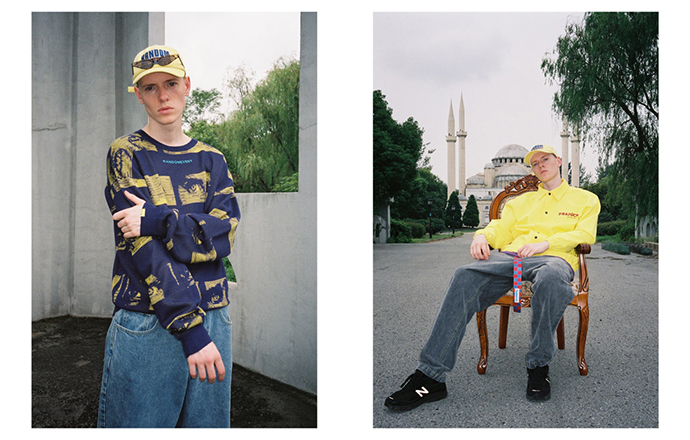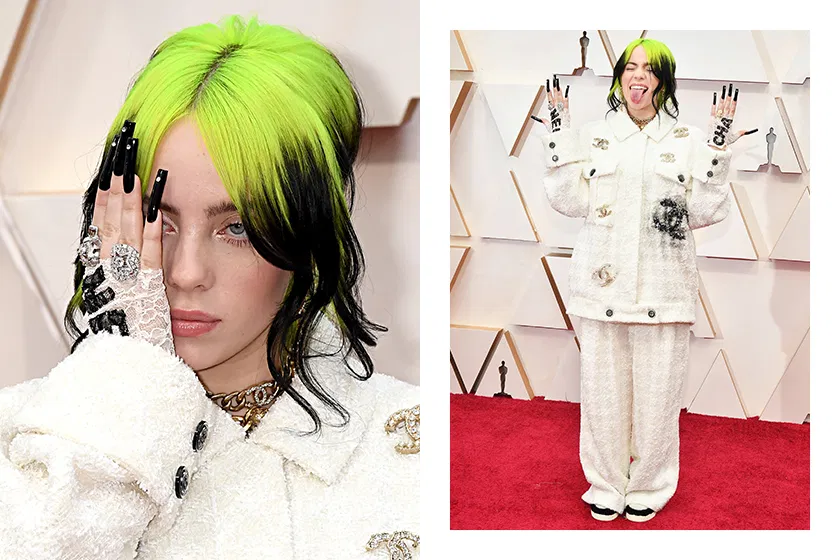Since 2019, the Weibo hashtag “Savory World-weary Makeup” (#盐系厌世妆#) has been gaining constant attention from trendy Gen-Z users, accumulating over 78 million views thus far. The Chinese phrase “world-weariness” has traditionally been another term for nihilism, but it has recently been redefined by younger consumers as an aesthetic category. As a subculture, it features a wide range of topics, from dark emo-style makeup and punk-inspired street fashion to cynical social media captions.
Chinese youngsters have always celebrated unique trends, from the “Non-Mainstream” (非主流) fever that defined an entire generation’s clothing style in the early 2000s to the more recent “Hanfu Movement” that honored traditional Chinese garments. Although the “world-weariness” trend is often seen via non-Chinese celebrities like American teen singer Billie Eilish, Kpop idol Lalisa Manoban, and Japanese actress Komatsu Nana, the fact that the subculture is gaining popularity in China shows that Gen Zers there crave alternative styles and new ways of expressing their identities.
Many local brands have acted on this demand, but Western luxury brands seem to be deliberately avoiding this trend. Since Gen Zers are becoming increasingly present in the marketplace, Jing Daily has taken a look at what exactly makes “World-weariness” pertinent to the luxury fashion community.
Brands should listen to Gen-Z preferences#

Constituting approximately 20 percent of China’s total population, Chinese Gen Zers currently make up 28 percent of the country’s luxury shoppers. As luxury brands aim to tap into this demographic, they need to understand the nuances behind Gen-Z preferences. “I think everyone who’s remotely into fashion owns some world-weary clothing,” said 21-year-old college student Chandler Wang to Jing Daily, “that’s why young people go crazy over Rick Owens.” Nicknamed “The Lord of Darkness,” Rick Owens and his gothic sportswear brand attracted a cult following of young fashion fanatics for his avant-garde designs and rebellious attitudes.
Brands that do well with Gen Zers seem to celebrate uniqueness and anti-society sentiments. “There is definitely a huge market for world-weary clothing,” Wang added. “Our generation is under a lot of societal pressure, and we embrace this attitude in our outfits.”
Perhaps that’s why the Chinese streetwear brand “Randomevent” became famous for its printed slogans “we don’t give a F about the world” and “not very nice (不怎么nice),” and the online Taobao store MAMC (毒库潮社) has printed T-shirts featuring words like “Struggle” and “Lonely Walk.” Understanding the new generation’s collective psyche — as well as the predecessors of this genre — is crucial to designer brands’ success with world-weary clothing.

But one style cannot holistically define an entire demographic, and brands need to objectively evaluate the whole range of the younger generation’s likes and dislikes — and what it means for their marketing. “While there are indeed generational traits amongst Gen Zers — digital-first, identity-driven, and for Chinese Gen Zers in particular, strong confidence culturally and economically — it’s important to remember that no cohort is entirely homogeneous,” said Ray Ju, the associate director of the global brand consultancy Labbrand in regards to the Gen-Z fashion demographic. “That is why you see ‘world-weariness’ becoming a phenomenon with this generation that’s otherwise considered to be aspirational.”
Brands need to acknowledge that even though Gen Zers generally value unpredictable niche aesthetics and subcultures, their preferences are largely influenced by economic and social contexts. One way to channel their language is by following trending social media hashtags and discussion forums, where Gen Zers creatively engage in self-expression.
Can Western brands seize this opportunity?#
In the US, the fashion industry has never been afraid to tap into the potential of alternative fashions, while sometimes growing alongside timely trends. When the counterculture fashion retail chain Hot Topic took the US by storm in the early 2000s, many assumed the sensation was just a flash in the pan.
However, the chain continued to grow because of its willingness to repurpose its products with ever-newer alternative trends, such as anime-related Tees and Billie Eilish merchandise. Versatility will likely lead to success, and Western brands should also consider harnessing related Chinese trends, especially considering China’s vast market and quick recovery after the COVID-19 outbreak. Luxury conglomerates are relying on China’s spending powers now more than ever, since the US and Europe are facing a slower-than-expected return from the outbreak, noted the managing consulting firm Bain & Company.

Chinese netizens have shown positive reactions about the luxury sphere expanding to include Gen-Z preferences, particularly when brands also happen to appeal to local trends. Most recently, the custom-made Chanel suit Billie Eilish wore at the 2020 Oscars defied Chanel’s traditional feminine appeal and instead reflected the singer’s signature oversized streetwear style, which sparked praise on the Chinese internet for its “world-weariness.”
One Weibo user commented, “I never thought Billie could make Chanel so cool and emo.” There is an obvious demand for bold collaborations in China, and after Chanel’s precedent, more grunge-style high fashion brands like today’s Celine and Saint Laurent (both of which are already popular in China) can broaden their reach through updated world-weary appeals.
The biggest challenge for luxury brands will be to overcome the cultural barrier when trying this approach. “The key is not letting a barrier prevent consumers from actively engaging with the brand,” Ju said. Particularly for luxury, cultural differences can be a prominent driver of a brand’s appeal, but when an appeal is done incorrectly, it can risk becoming a hindrance rather than a help.
“For example, ‘authenticity’ is one of the topics repeatedly touted by Western brands,” he explained, “but for Chinese consumers, this could read very differently from the brand’s original Western point of view. Some attributes like ‘rebellion’ or ‘free spirit’ can go wrong and may even pose political risks.” Indubitably, branding localization in China requires specific rules as well as deep insight into local backgrounds.
The question for brands isn’t if, but rather, how to take action when confronted with newer Chinese trends. “It’s important to evaluate the underlining drive of [world-weary] behavior and whether it reflects a cultural shift that will have a sustainable impact,” Ju stated. “There’s a profit to be made, but it also comes with the risk of affecting the consistency of a brand.”
In a time of uncertainty and hyper-globalization, it’s already difficult for brands to stay afloat of market developments and retail model changes. Yet, ultimately, if brands want to expand their horizons and break into China’s Gen-Z market, they have to find a middle ground between chasing transient trends and maintaining long-term success.
